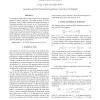Free Online Productivity Tools
i2Speak
i2Symbol
i2OCR
iTex2Img
iWeb2Print
iWeb2Shot
i2Type
iPdf2Split
iPdf2Merge
i2Bopomofo
i2Arabic
i2Style
i2Image
i2PDF
iLatex2Rtf
Sci2ools
ICASSP
2011
IEEE
2011
IEEE
Computing room acoustics with CUDA - 3D FDTD schemes with boundary losses and viscosity
In seeking to model realistic room acoustics, direct numerical simulation can be employed. This paper presents 3D Finite Difference Time Domain schemes that incorporate losses at boundaries and due to the viscosity of air. These models operate within a virtual room designed on a detailed floor plan. The schemes are computed at 44.1kHz, using large-scale data sets containing up to 100 million points each. A performance comparison is made between serial computation in C, and parallel computation using CUDA on GPUs, showing up to 80 times speed-ups. Testing on two different Nvidia Tesla cards shows the benefits of the latest FERMI architecture for double precision floating-point computation.
Finite Difference Time Domain | ICASSP 2011 | Precision floating-point Computation | Realistic Room Acoustics | Signal Processing |
| Added | 21 Aug 2011 |
| Updated | 21 Aug 2011 |
| Type | Journal |
| Year | 2011 |
| Where | ICASSP |
| Authors | Craig J. Webb, Stefan Bilbao |
Comments (0)

